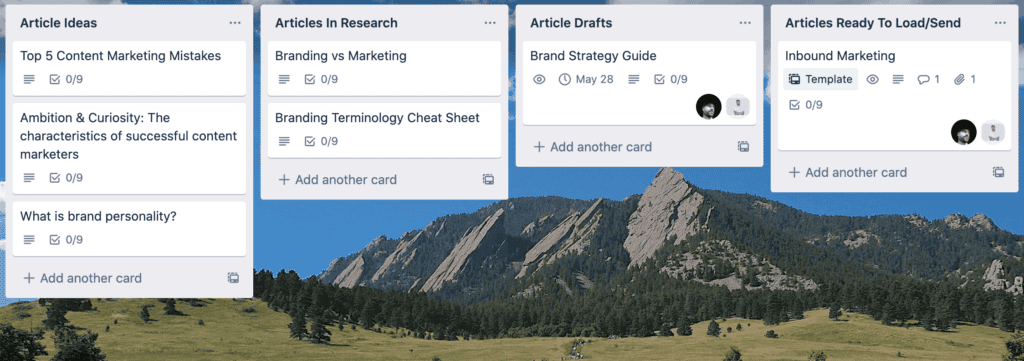
I stumbled across the book Inbound Marketing from Dharmesh Shah and Brian Halligan of Hubspot back in the summer of 2010. It changed the way I think about marketing and paved the way for creating my own demand generation framework.
Inbound marketing is now the driving force in my career. I use it to shape my decisions and build my business. If you like the idea of hungry buyers devouring your content and showing up at your door with bags of money, keep reading…
What is inbound marketing, and why should I care?
Inbound marketing is exactly what it sounds like. It’s a way to pull customers to you by delivering value before a sale happens. The strategy is built around answering questions, solving problems, and showcasing your expertise on a subject.
I can attribute 70% of my business revenue directly to inbound marketing. The other 30% comes from referrals. That means 100% of my revenue is from people coming to my door with money in hand and a problem to solve.
Those numbers may diversify further as I begin to test paid placement to spike awareness and saturate specific niches, but inbound will still be the heart and 5,000 horsepower soul of my business development strategy. Consider this…
In the span of just one year, from 2018 to 2019, the total number of devices around the world with ad blockers rose from 142 million to upwards of 615 million.
That’s a startling fact.
People are always searching for wonderful new products and services, but it’s obvious they don’t want ads telling them where to get them. That’s why you should care about inbound marketing. It’s an opportunity to earn the trust of the right people and turn them into paying customers and rabid fans of your brand.
Is it hard? Yes.
Is it worth the time and effort? Yes.
Is your niche too saturated? No.
I write about branding and marketing. I’m competing for keywords against the best marketers in the world. That’s not an exaggeration. Neil Patel, Hubspot, Mozz, and countless other content marketing juggernauts are going after many of the same phrases as me. None of these companies are direct competitors for business, but they are when it comes to Google.
Still, as I told you, I’ve been able to drive consistent results for Special Sauce even though we’re only a little over a year old and a tiny spec on the Google radar. We started from scratch with zero domain authority, no social presence, and not a lick of content. I highlight my experience to point out that no matter what niche you’re in (or how young or old your company is), there’s still a wealth of opportunity to leverage inbound marketing.
Inbound Marketing vs Outbound Marketing
It’s important to understand how an inbound approach differs from traditional outbound strategies. Inbound is a pull method where you attract people to your content by delivering value. Outbound is a push method where you’re trying to interrupt and persuade someone to do something with a clever ad or persuasive salesperson.
I’m a believer, user, and teacher of inbound marketing, but I do feel there is a place for outbound techniques in many companies.
That said, if you’re a small to mid-size company with limited resources, put them toward an inbound strategy. Outbound techniques are only as good as the money you spend. Inbound approaches have a compound interest effect where they grow in value over time.
Here’s a simple breakdown of how they stack up:
Inbound Marketing
- Pulls customers to you.
- Gives the customer information they want.
- Customers find you based on a question or problem.
- Involves blogging, article writing, video, podcasts, social media, email newsletters, and select paid vehicles like Google Ads.
- Is not for the person seeking shortcuts or growth hacks. It requires work and consistency.
- You attract customers through search engines, social media, blog subscriptions, and emails.
- Positions your brand as an expert on a topic.
- Takes time to establish, but it pays off for months, years, or decades once established.
Outbound Marketing
- Interrupts people.
- Asks the reader or viewer to stop what they’re doing and do something else.
- You must find, interrupt, and persuade the right people to take action.
- Involves direct mail, print advertising, banner ads, cold (calling, emailing, LinkedIn prospecting, etc…), and tradeshows.
- Requires budget to put your brand in a position to interrupt the right people.
- May give you immediate gratification, but it only lasts as long as you spend money.
Outbound is old-school. It worked for decades, but it’s dying. The internet, mobile phones, and shifting consumer behaviors are squeezing industries that are built on an interruption advertising model. Knowing this, I feel confident recommending a shift to a demand generation strategy with inbound marketing playing the lead role.
How to get started with inbound marketing (and the biggest mistakes to avoid).
You won’t be a certified inbound marketing expert when we’re done here, but you’ll be ready to get that inbound strategy off the ground. I’ve broken this down into manageable steps anyone can execute with some work. If you’re allergic to work—this strategy isn’t for you.
Step 1: Pick your content engine.
Ambition is one of the greatest indicators of success for inbound marketing. You need ambition to fight through the early stages of your efforts when it feels like you’re talking to an empty room. Drive is an intangible you can’t teach.
However, ambition can also be the death of your efforts. Many ambitious people (including me) start out wanting to tackle blogging, YouTube, and podcasting all at once. This is a guaranteed path to failure. Even billion-dollar brands struggle to produce compelling written, video, and audio content.
Instead, pick one primary type of content you’re going to use as an engine. Will you write, produce videos, or use audio content? What is a natural fit for you and the resources within your company? Pick your engine based on fit for your talents, not what’s popular in the marketing community at the moment.
Obsess about becoming great at producing content via your engine. You can repurpose that content down the road, but you must become remarkable in one space in order to get shares, reads, views, or links from people consuming what you produce.
Step 2: Craft your content manifesto
You’ve nailed down your engine. Now it’s time to write a manifesto to keep your content focused. Your audience will grow if you consistently deliver on a promise. Serve up value to a specific audience that helps them achieve a goal. That’s really all there is to inbound marketing.
We use a simple framework to vocalize this idea. We call it your content manifesto and it’s the backbone of an inbound marketing strategy. Fill out this prompt…
Our content is where [audience X] gets [content Y] to help them [benefit Z].
This one line will help you vocalize your audience, the content you’re going to provide them, and what that content is going to help them achieve.
Step 3: Build a content schedule.
Another mistake that destroys an inbound strategy is the hare approach. You know the story of The Tortoise and the Hare. The hare jumps out of the gate and starts running full speed. No strategy. No planning. It’s full speed ahead until the tank is empty.
The hare approach is what I call it when you see a blog that has about ten posts in two weeks and then complete silence for six months. They were so excited about this new blog that they failed to plan their content. The pace they set isn’t sustainable in the marathon that is content marketing.
Instead, take some time to lay out a plan. Start by gathering a list of questions you frequently answer. Don’t worry about keywords at this point. Sit down and write as many questions as possible.
Where do customers struggle?
What questions do you repeatedly get from prospects and customers?
Provide the best answer to the questions your customers are asking and you’ll be rewarded with traffic and revenue.
Now do your keyword research. Each blog post, video, or podcast needs to tackle a specific topic. Keywords are how Google will find that topic and serve it up to the right people searching for answers.
We use SEMRush* for our keyword research. It gives you a wealth of insights as well as several free training courses on SEO, PPC, content marketing, and other search engine related topics.
Once you’ve nailed down the questions you’ll answer and the keyword niches to target, you can move into laying out a schedule. We use Trello to organize our content. Below you can see our content schedule and the different phases of articles Jake and I are working on at the moment.

That brings us to the real work…
Step 4: Produce badass content.
Look at the top organic posts on the topic you’re targeting and produce something better. You can use SEMRush to identify the top organic results, or you can go into a private window on your browser and do a Google search. Study those top 5 organic listings (organic refers to the first options below the ads). These are the websites that have earned the favor of Google.
Identify what they all have in common, and what none of them have. Studying the people currently winning on Google gives you a roadmap on what must be there to rank and where there are holes for you to provide unique value. Make this a standard step in your writing process.
Speaking of processes, create one for your content team. It’ll make your life easier and content stronger. Writing and editing shouldn’t happen at the same time. Both are vital to a high-quality post, but they’re impossible to do simultaneously. Adding links, finding great images, creating a strong post graphic to demand attention on social, and killing your headline also need to be covered.
Set yourself up for success with a process checklist. It’ll help you make sure nothing is missed and give your post the best shot of earning space on the mighty Google machine. Here’s our post checklist as an example.

I shot from the hip with my content development when I started. I wrote what I wanted when inspiration hit. There are multiple problems with this approach.
- Shooting from the hip becomes impossible as more people begin to participate in content development.
- You end up with content that’s all over the place. It may make sense in your head, but it’s hard to follow as a reader. You’ll struggle to gain traction with readers or search engines.
- You miss deadlines and have content gaps. It’s much easier to deliver consistently if you have a content plan that can be chipped away at over time rather than sitting down and trying to bang out a quality post in one day.
Don’t shoot from the hip. Spend a few minutes to plan your attack. A little extra time today will save you massive amounts of frustration in the future.
Step 5: Promote your content.
Your job isn’t done when a post is up. A successful inbound strategy requires shameless self-promotion. You can’t sit back and hope Google finds you.
Google will find you if you relentlessly promote your work and help real people make their way to your content. If it’s good, those people will share it and attract Google spiders crawling the interwebs.
I know it’s intimidating to share your content on social media. Trust me, I had a hard time getting past this at first. What finally broke down the self-consciousness was when people started reaching out to tell me thanks for helping them through articles. Fight through the fear and become your own best advocate.
Focus on one or two awareness channels (a.k.a. social media sites) with your promotion. Like we talked about above, it’s hard to grow and maintain Instagram, LinkedIn, Facebook, Twitter, Medium, Pinterest, Snapchat, YouTube, TikTok, etc…
Figure out the top two places where your buyers are and become great on those platforms. Pop over to our B2B Marketing Guide and scroll down to the bottom for a step-by-step guide to posting content on LinkedIn.
Conclusion
Inbound marketing is a compound interest game. Making consistent deposits of value adds up to a wealth of leads coming to you. It’s not easy, but it’s worth the time, effort, and resources you put toward executing the strategy. Follow the above steps and you’ll be up and running in no time. If you’re looking for an agency who can produce compelling content for you, here’s what you do:
1. Send us a note with a few details.
2. Jump on the phone to tell us all about your business and goals (no commitment or hard sell, we’ll just chat about your business).
3. If we sound like the right fit to help, we’ll lay out a strategy unique to your business.
4. Enjoy buyers walking in your door.
Not ready to get in touch? Grab The Recipe so you can get to know us deeper and get a feel for our personality.
* We are SEMRush affiliates so we make a little cheddar if you click on that link above and decide to purchase. However, we don’t recommend SEMrush because we’re affiliates. We do so because we use it (religiously) and feel it’s the best tool.